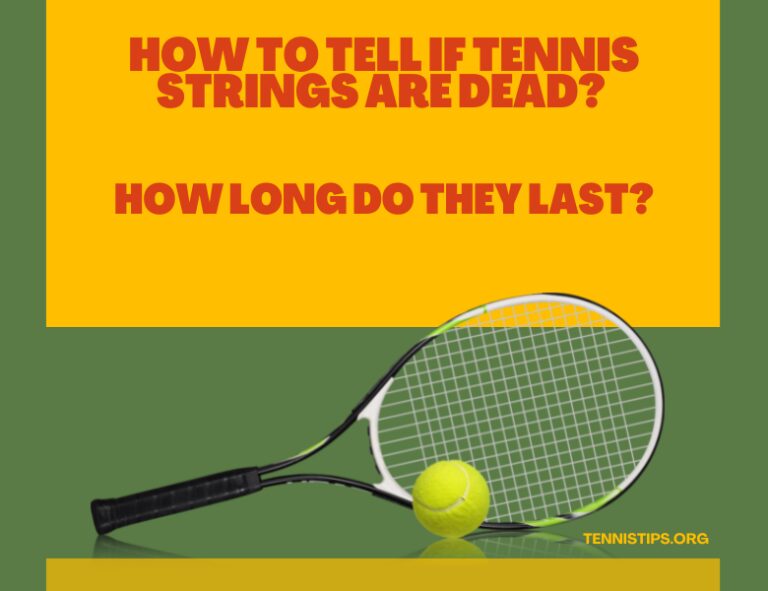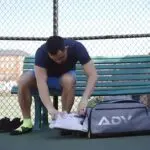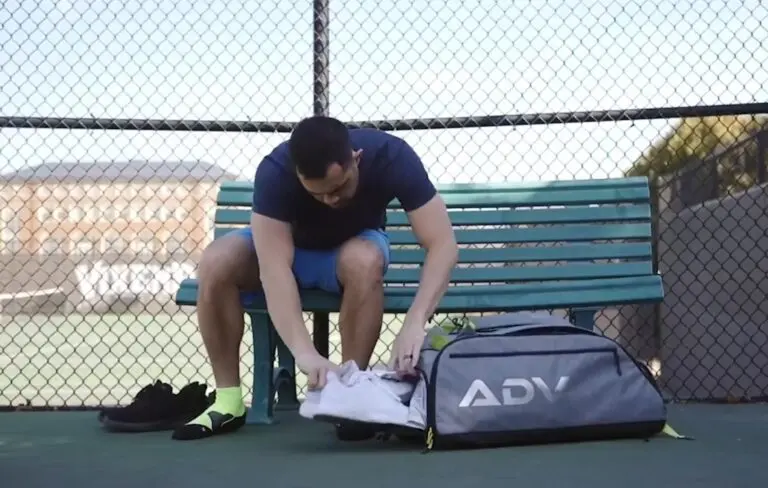During a heated tennis match, amidst intense back-and-forth rallies, my trusted racquet betrayed me. With a resounding “twang,” the string snapped right in the middle, leaving me stunned.
I always took the best care of my gear, but from that day, I upped that tenfold, making sure my trusty partner was always in top shape. So:
- how do you know if your tennis strings are dead?
- how long do tennis strings last?
- can you just replace the strings?
- do you need to replace your racquet?
We will cover these factors below, and in the process get you more attuned with your racquet on the court. Never again let a broken string ruin your fun out on the court.
How To Tell If Tennis Strings Are Dead?

If you are an experienced player, you will notice if your racquet is lacking the pop to really make the ball fly. However, if you are frequently using a racquet, you may not notice this gradual decline.
Essentially, when strings die, they lose the power to remain fixed in place. This lack of resiliency concludes that the strings are dead.
However, it’s also very common for a string to die long before they move. Nonetheless, if your strings are shifting, it is time to replace them. Some ky signifiers are below:
1. Movement of the strings
If you notice that the strings are vibrating when you are playing, or you have to touch them to realign. This indicates that the strings are in danger of falling off.
This will be the most unmistakable indication that the tennis strings have gone. If you’re already at this stage, then you should replace them immediately.
2. Developing some shoulder or wrist problems
If you feel you are overexerting while playing tennis, to get the some pop off the racquet you used to feel, this is a good sign the strings are about to break.
Don’t work too hard to increase the intensity as the strings get older. Not only will you break the strings, but you also increase your own chance of a shoulder or wrist injury.
3. Loss of tension

Tension in tennis strings decreases how hard it is to produce power. This is why it is easier to sustain an injury as you swing harder when tension is reduced.
You can see this visually as well as feel it on your racquet. There are several tennis racquet stringing machines that will help you maintain your tool, and reduce the aging of your strings.
4. The “tone” of your tennis shots begins to get lost
A very personal feeling, but everybody has a different playing style, and when playing with a well-strung racquet, everything JUST FEELS RIGHT. Since I have re-tightened my strings, I have greater control over my serves.
If you find the need to drive your shots harder to produce more pace or if your shot contact across the net is getting weaker, this is a strong indication that your strings need to be replaced.
5. The ball sounds different when it hits your strings
When you hit the strings, you could get a pleasing ‘ping’ noise when they are fresh. When the strings are near exhaustion, it sounds like a soft thud.
If you are confused, start listening to the tone of other rackets before the game or when you warm up. I tested this with other players at my local court the other day, and many of them would benefit from racquets being restrung!
How long do tennis strings last?
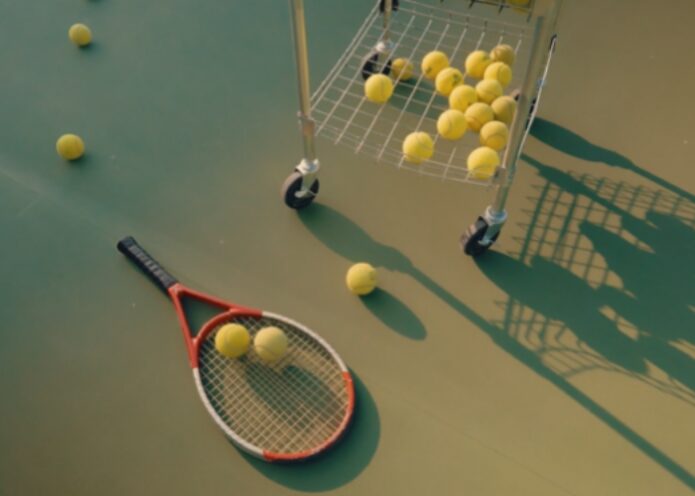
The life of tennis racquet strings relies on how often used and how they are maintained. Most frequent tennis players require a new racquet (or a restringing) two to three times a year, whereas professionals use them daily.
Types of Tennis Racquet Strings
Polyester is the most common type of string used for tennis racquets worldwide, but there are some other types out there also
1. Synthetic Gut
Made of Nylon material and composed of a single filament. It can last 1-2 Games.
2. Natural Gut
Made of animal intestines. Its duration depends on usage.
3. Multi-Filament
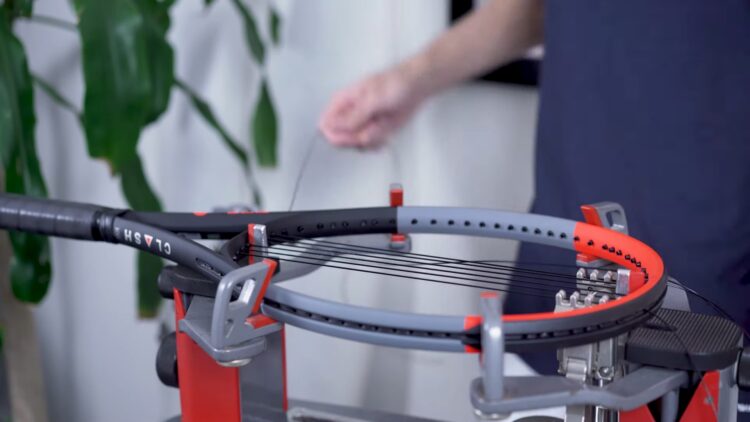
Made from more than one filament, usually Nylon, but it could also include polyurethane and Kevlar. Depending on the materials used, its duration varies.
4. Nylon
Doesn’t last well, particularly if you don’t wear a wear-resistant layer.
5. Polyester
Tension holding ability is not great. It may vary depending on the play style.
How long does it take to restring a tennis racket?
An experienced restringer can get it done in 20 minutes with their own machine at home. A novice could take up to an hour. I suggest buying your machine if you plan on making tennis a longterm hobby.
Beginner (plays once a month)
A novice is new to the game or plays infrequently. For such a level, we advise having the racquet restrung every three months.
Although the string likely won’t snap, the pitch of your strings (how high or low) can vary. Frequent restringing at three-month intervals keeps your tennis stress constant, providing a more stable experience.
Intermediate (plays 3-4 times a month)
Someone who has been involved in the game for a few years but is only now getting serious about it. You have invested some money in your instruments, so we suggest this player gets their racquet restrung every month. It is necessary to retain your strings’ tension regardless of whether you are competing or just casually playing.
Advanced (plays 4-7 days a week)
Junior events and higher-level competitors who are familiar with the process of restringing. The rule of thumb for those practicing 4-7 weeklong sessions is to “restring when you split.”
An advanced players strings will snap every few weeks. For experienced players, we suggest stringing the racquet as much as possible and definitely before any tournament. No matter how much you play, maintained equipment will have the greatest impact while you’re hitting the coourt.
How much does it cost to replace a tennis racket?
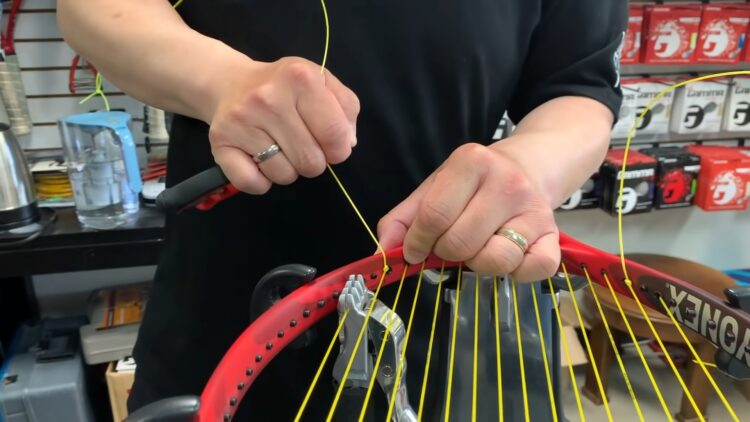
It’s a cheap and healthy form of recreation for singles and families alike. Beginning racquets usually costs between $20 to $40 and can last for years if cared for properly. Despite this, no machinery is indestructible.
Although the cost of racket strings is poor, variables influence the price greatly. Your overall costs will increase when you utilize and treat your strings more effectively. If you require your racquet to be restrung often, then invest in an restringer.
Brand Issue
The total cost of stringing a tennis racquet differs between different brands. You will also often get a discount when you purchase strings from a sports retailer.
The cost of a simple string ranges from $10 to $15. On the other hand, high-quality strings can run over $100. Installation costs will range from $10 to $20.
Prevention
The biggest savings are possible if you take care of your instruments. Keep the racquet inside the cover whenever possible to avoid clogging the pinholes or scratching the surface.
Store your equipment securely and nowhere damp or hot. That is not in basements, attics, or trunks that will heat up rapidly. Such exposure allows the strings to stretch and shrink, resulting in a loss of flexibility.
Conclusion
There are several variables to consider while you are using your tennis racquet, so only you can know if it isn’t up to snuff. Keep your gear maintained, and pay attention to the sounds and feel of your racquet.
By following our guidelines, you will get to the top of your game, and stay on top.
FAQ

How do you know when the tennis strings would be changed?
We suggest having your strings changed a MINIMUM every three months
Do tennis strings have a shelf life?
Unfortunately they do. But the better you look after them, the longer they will last!
Which tennis strings last the longest?
Polyester is the sturdiest, while gut strings are the least durable.
In general, a string gauge of 15 are durable and dense, and will last longer. A gauge of 18 is “small” and has a much shorter life.
References:
https://sportsshop.sg/blogs/news/how-often-should-you-restring-your-tennis-racket
https://www.active.com/tennis/articles/racket-tech-how-to-know-when-to-restring

